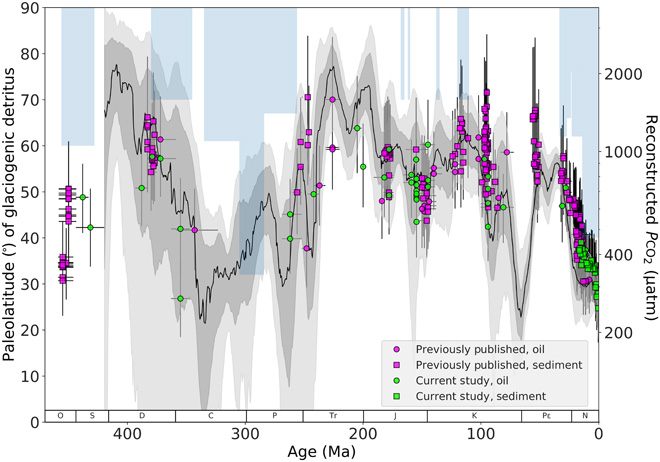500 million years long history of CO2 revealed
NESSC-scientists have reconstructed the history of varying CO2-concentrations for a record 500 million years. Researchers at the Netherlands Institute for Sea Research (NIOZ) and Utrecht University recovered the ancient CO2-concentrations by studying preserved remnants of pigment molecules of marine algae. The research article, published online in Science Advances, also implies that the increase of CO2-levels in the atmosphere as observed during this century used to take millions of years.
The new reconstruction shows how CO2-concentrations rose and fell in the earth’s atmosphere during nearly half a billion years in the geological past of the planet. NESSC-researcher Caitlyn Witkowski, first author of the paper and PhD student at NIOZ, says: “In our data, we see very high levels of carbon dioxide, reaching 1000 ppm as opposed to today’s 410 ppm. In this respect, present day CO2-levels are not unique – but we have never seen the speed of these changes before. Changes that typically take millions of years are now happening in a century. This additional CO2-data may help us understand the future of our planet.”
Phytane

For their reconstruction, Witkowski and colleagues selected hundreds of samples of marine sediments from all over the globe. A breakthrough in their research was the usage of only one indicator to infer a continuous record of CO2-levels in deep time: phytane, a degradation product of the green pigment chlorophyll. Earth scientists often use different kinds of indicators (proxies) from plants and chemicals stored in ancient ocean sediments to reconstruct past environmental conditions.
Because chlorophyll is found all around the world, phytane is also found everywhere. Witkowski: “Phytane doesn’t change chemically over the course of time, even if it is millions of years old. With phytane, we now have the longest CO2-record with one single marine proxy. This new data is invaluable to modelers who can now more accurately make predictions of the future.”

Going farther in time
To better predict the planet’s future climate conditions, earth scientists study the long-term changes in atmospheric CO2 and the climate of the earth. A prerequisite for this research is reliable knowledge about CO2-concentrations over geologic history. The development of phytane as proxy allows scientists to look even further back in time, even before the Cambrian, the geological period when life on earth began to develop. Phytane has been found even in two billion years old samples. Witkowski: “We developed and validated a new way to time travel – going farther in time and to more places.”
Article:
Molecular fossils from phytoplankton reveal secular pCO2 trend over the Phanerozoic
Science Advances, 2018.
Caitlyn R. Witkowski, Johan W.H. Weijers, Brian Blais, Stefan Schouten, and Jaap S. Sinninghe Damsté
Caitlyn also recently featured in this Tipping Point Ahead video:

